fuel type VOLVO S90 1998 Owners Manual
[x] Cancel search | Manufacturer: VOLVO, Model Year: 1998, Model line: S90, Model: VOLVO S90 1998Pages: 175, PDF Size: 4.45 MB
Page 74 of 175
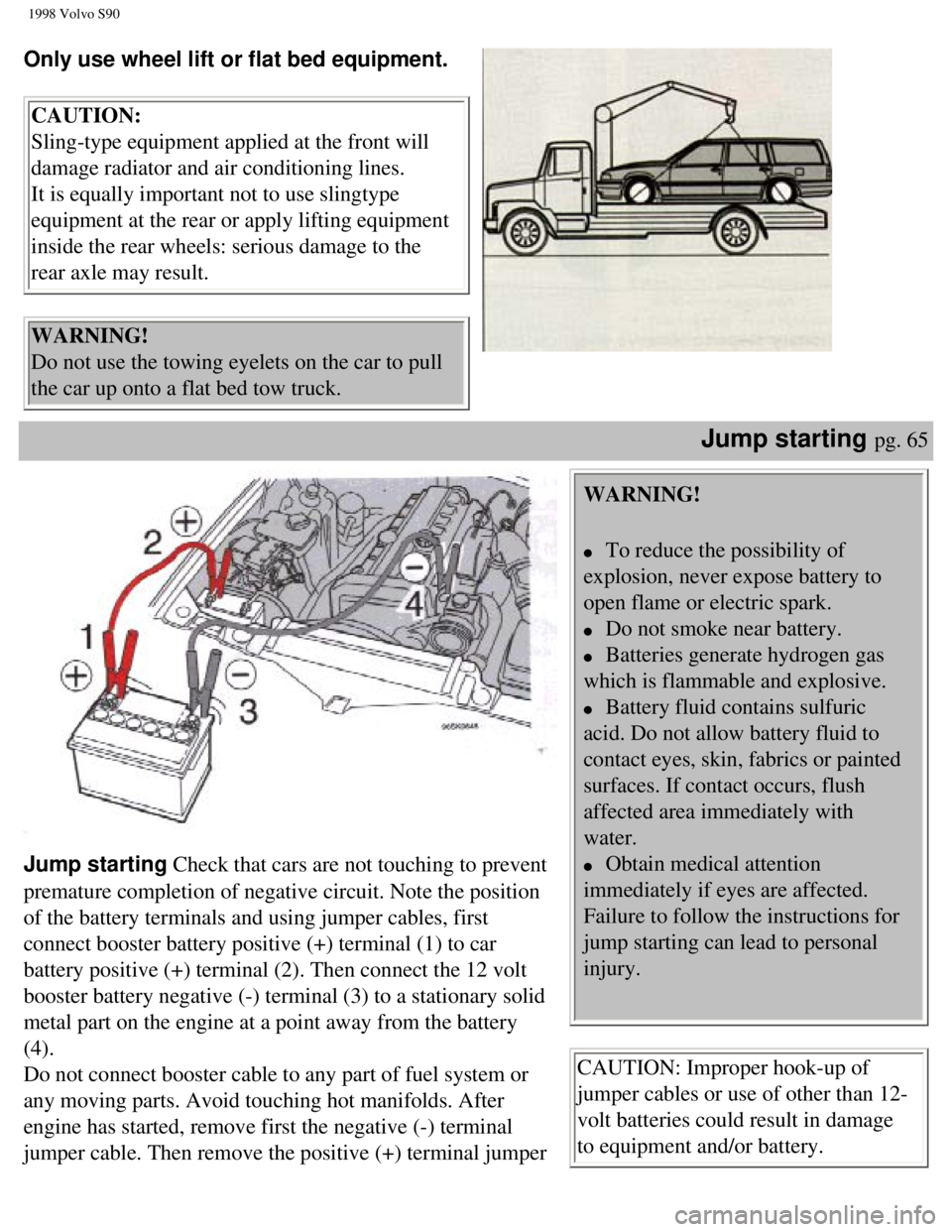
1998 Volvo S90
Only use wheel lift or flat bed equipment.
CAUTION:
Sling-type equipment applied at the front will
damage radiator and air conditioning lines.
It is equally important not to use slingtype
equipment at the rear or apply lifting equipment
inside the rear wheels: serious damage to the
rear axle may result.
WARNING!
Do not use the towing eyelets on the car to pull
the car up onto a flat bed tow truck.
Jump starting pg. 65
Jump starting Check that cars are not touching to prevent
premature completion of negative circuit. Note the position
of the battery terminals and using jumper cables, first
connect booster battery positive (+) terminal (1) to car
battery positive (+) terminal (2). Then connect the 12 volt
booster battery negative (-) terminal (3) to a stationary solid
metal part on the engine at a point away from the battery
(4).
Do not connect booster cable to any part of fuel system or
any moving parts. Avoid touching hot manifolds. After
engine has started, remove first the negative (-) terminal
jumper cable. Then remove the positive (+) terminal jumper
WARNING!
l To reduce the possibility of
explosion, never expose battery to
open flame or electric spark.
l Do not smoke near battery.
l Batteries generate hydrogen gas
which is flammable and explosive.
l Battery fluid contains sulfuric
acid. Do not allow battery fluid to
contact eyes, skin, fabrics or painted
surfaces. If contact occurs, flush
affected area immediately with
water.
l Obtain medical attention
immediately if eyes are affected.
Failure to follow the instructions for
jump starting can lead to personal
injury.
CAUTION: Improper hook-up of
jumper cables or use of other than 12-
volt batteries could result in damage
to equipment and/or battery.
file:///K|/ownersdocs/1998/1998_SV90/98S90_063.htm (2 of 4)12/30/2006 \
1:52:43 PM
Page 79 of 175
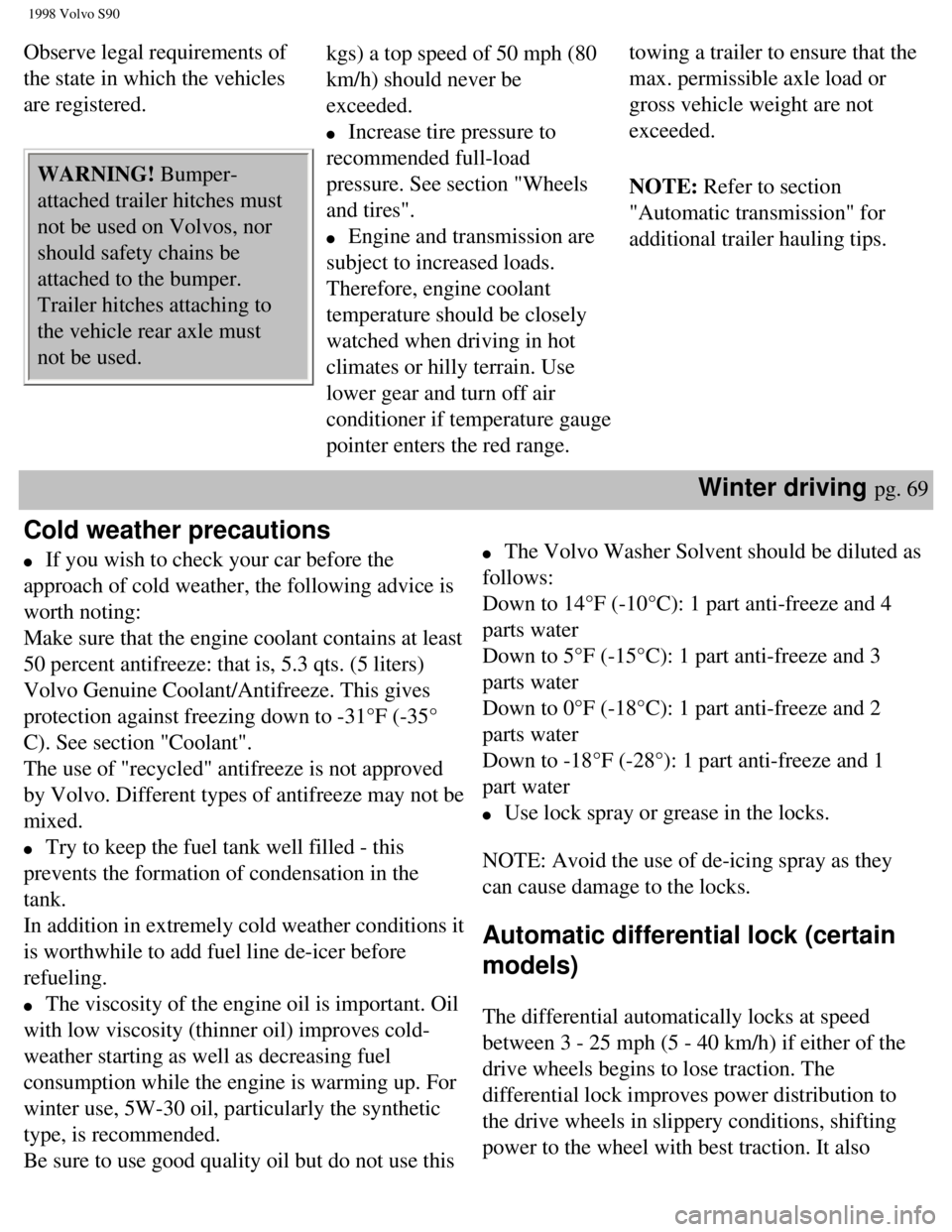
1998 Volvo S90
Observe legal requirements of
the state in which the vehicles
are registered.
WARNING! Bumper-
attached trailer hitches must
not be used on Volvos, nor
should safety chains be
attached to the bumper.
Trailer hitches attaching to
the vehicle rear axle must
not be used. kgs) a top speed of 50 mph (80
km/h) should never be
exceeded.
l Increase tire pressure to
recommended full-load
pressure. See section "Wheels
and tires".
l Engine and transmission are
subject to increased loads.
Therefore, engine coolant
temperature should be closely
watched when driving in hot
climates or hilly terrain. Use
lower gear and turn off air
conditioner if temperature gauge
pointer enters the red range.
towing a trailer to ensure that the
max. permissible axle load or
gross vehicle weight are not
exceeded.
NOTE: Refer to section
"Automatic transmission" for
additional trailer hauling tips.
Winter driving pg. 69
Cold weather precautions
l If you wish to check your car before the
approach of cold weather, the following advice is
worth noting:
Make sure that the engine coolant contains at least
50 percent antifreeze: that is, 5.3 qts. (5 liters)
Volvo Genuine Coolant/Antifreeze. This gives
protection against freezing down to -31°F (-35°
C). See section "Coolant".
The use of "recycled" antifreeze is not approved
by Volvo. Different types of antifreeze may not be
mixed.
l Try to keep the fuel tank well filled - this
prevents the formation of condensation in the
tank.
In addition in extremely cold weather conditions it
is worthwhile to add fuel line de-icer before
refueling.
l The viscosity of the engine oil is important. Oil
with low viscosity (thinner oil) improves cold-
weather starting as well as decreasing fuel
consumption while the engine is warming up. For
winter use, 5W-30 oil, particularly the synthetic
type, is recommended.
Be sure to use good quality oil but do not use this
l The Volvo Washer Solvent should be diluted as
follows:
Down to 14°F (-10°C): 1 part anti-freeze and 4
parts water
Down to 5°F (-15°C): 1 part anti-freeze and 3
parts water
Down to 0°F (-18°C): 1 part anti-freeze and 2
parts water
Down to -18°F (-28°): 1 part anti-freeze and 1
part water
l Use lock spray or grease in the locks.
NOTE: Avoid the use of de-icing spray as they
can cause damage to the locks.
Automatic differential lock (certain
models)
The differential automatically locks at speed
between 3 - 25 mph (5 - 40 km/h) if either of the
drive wheels begins to lose traction. The
differential lock improves power distribution to
the drive wheels in slippery conditions, shifting
power to the wheel with best traction. It also
file:///K|/ownersdocs/1998/1998_SV90/98S90_067.htm (3 of 5)12/30/2006 \
1:52:43 PM
Page 121 of 175
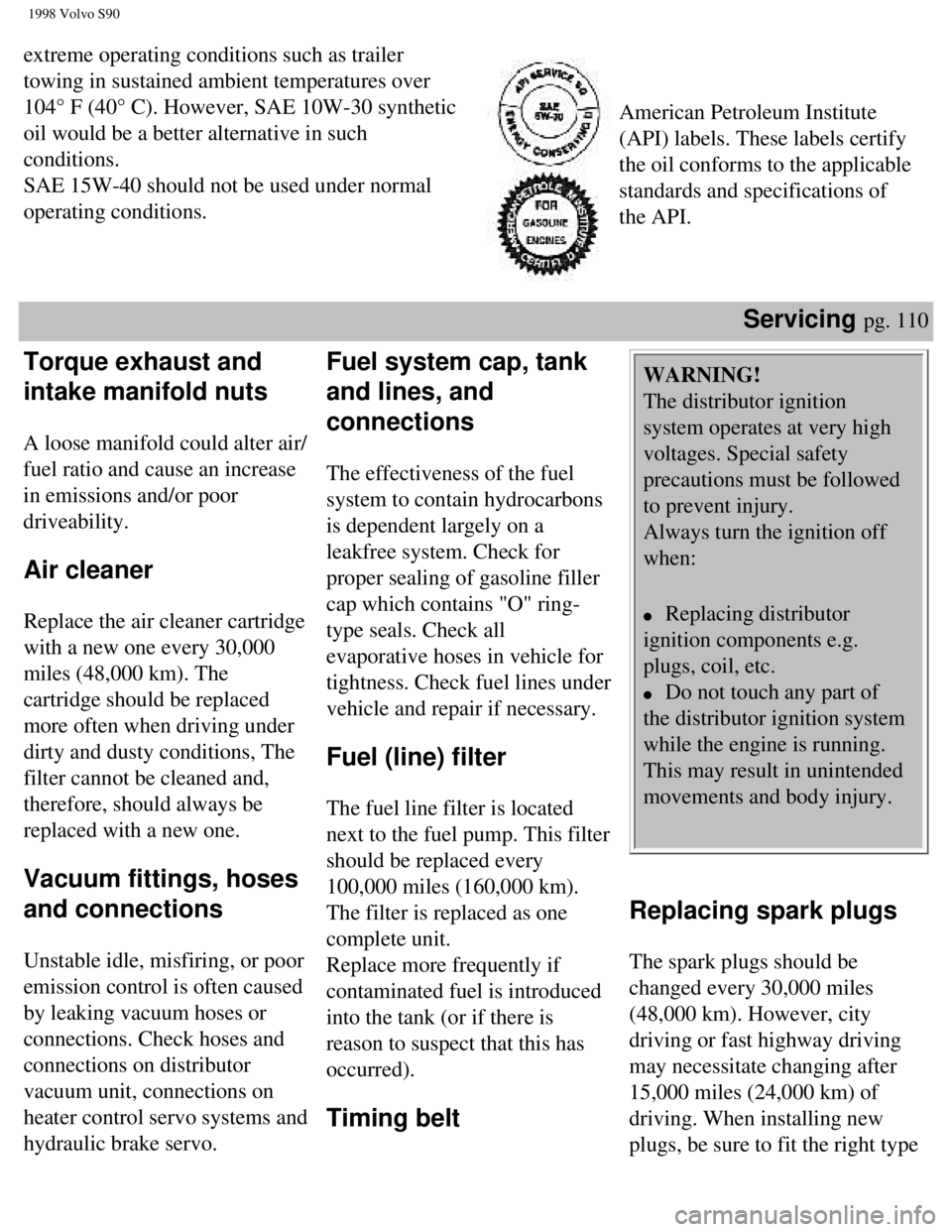
1998 Volvo S90
extreme operating conditions such as trailer
towing in sustained ambient temperatures over
104° F (40° C). However, SAE 10W-30 synthetic
oil would be a better alternative in such
conditions.
SAE 15W-40 should not be used under normal
operating conditions.
American Petroleum Institute
(API) labels. These labels certify
the oil conforms to the applicable
standards and specifications of
the API.
Servicing pg. 110
Torque exhaust and
intake manifold nuts
A loose manifold could alter air/
fuel ratio and cause an increase
in emissions and/or poor
driveability.
Air cleaner
Replace the air cleaner cartridge
with a new one every 30,000
miles (48,000 km). The
cartridge should be replaced
more often when driving under
dirty and dusty conditions, The
filter cannot be cleaned and,
therefore, should always be
replaced with a new one.
Vacuum fittings, hoses
and connections
Unstable idle, misfiring, or poor
emission control is often caused
by leaking vacuum hoses or
connections. Check hoses and
connections on distributor
vacuum unit, connections on
heater control servo systems and
hydraulic brake servo.
Fuel system cap, tank
and lines, and
connections
The effectiveness of the fuel
system to contain hydrocarbons
is dependent largely on a
leakfree system. Check for
proper sealing of gasoline filler
cap which contains "O" ring-
type seals. Check all
evaporative hoses in vehicle for
tightness. Check fuel lines under
vehicle and repair if necessary.
Fuel (line) filter
The fuel line filter is located
next to the fuel pump. This filter
should be replaced every
100,000 miles (160,000 km).
The filter is replaced as one
complete unit.
Replace more frequently if
contaminated fuel is introduced
into the tank (or if there is
reason to suspect that this has
occurred).
Timing belt
WARNING!
The distributor ignition
system operates at very high
voltages. Special safety
precautions must be followed
to prevent injury.
Always turn the ignition off
when:
l Replacing distributor
ignition components e.g.
plugs, coil, etc.
l Do not touch any part of
the distributor ignition system
while the engine is running.
This may result in unintended
movements and body injury.
Replacing spark plugs
The spark plugs should be
changed every 30,000 miles
(48,000 km). However, city
driving or fast highway driving
may necessitate changing after
15,000 miles (24,000 km) of
driving. When installing new
plugs, be sure to fit the right type
file:///K|/ownersdocs/1998/1998_SV90/98S90_108.htm (3 of 6)12/30/2006 \
1:52:49 PM
Page 131 of 175
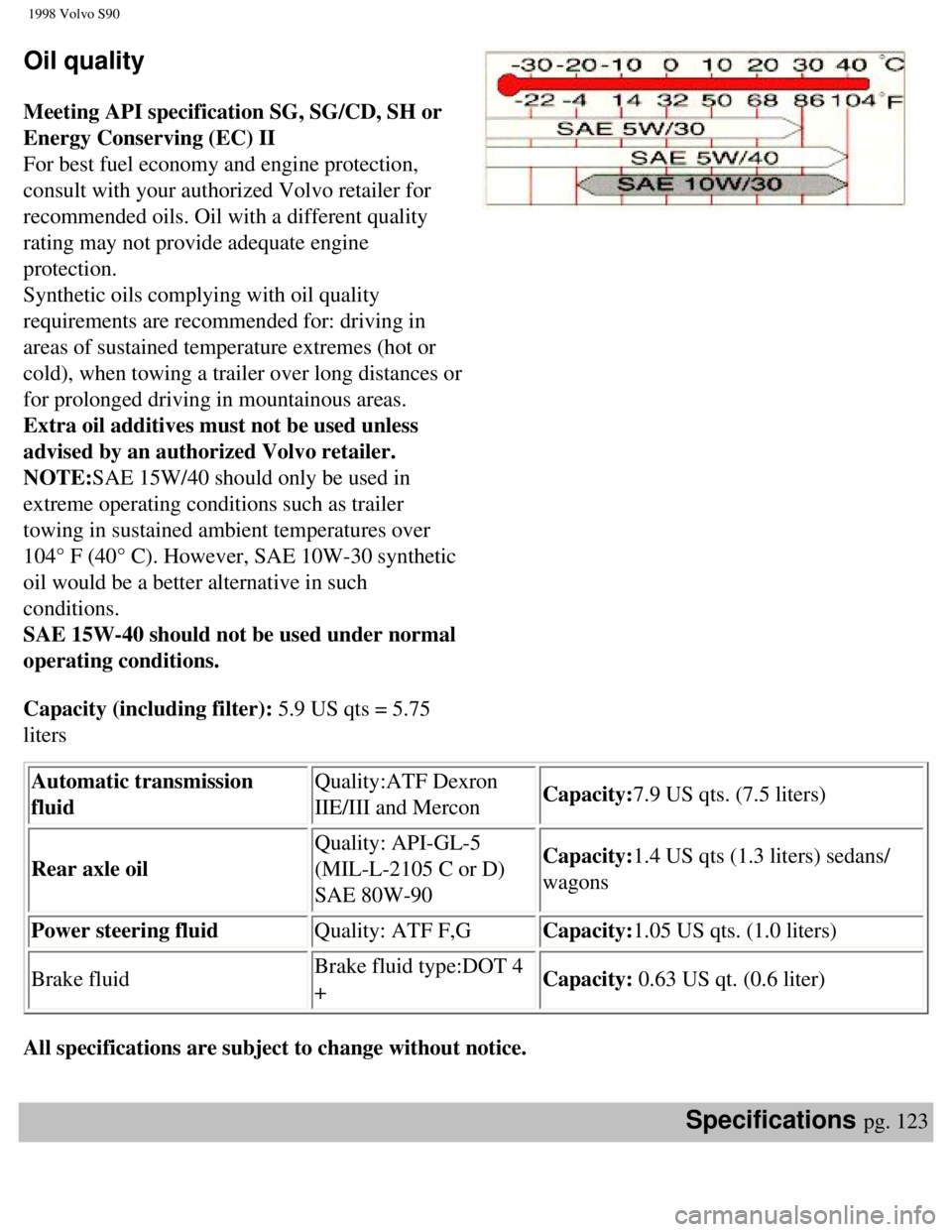
1998 Volvo S90
Oil quality
Meeting API specification SG, SG/CD, SH or
Energy Conserving (EC) II
For best fuel economy and engine protection,
consult with your authorized Volvo retailer for
recommended oils. Oil with a different quality
rating may not provide adequate engine
protection.
Synthetic oils complying with oil quality
requirements are recommended for: driving in
areas of sustained temperature extremes (hot or
cold), when towing a trailer over long distances or
for prolonged driving in mountainous areas.
Extra oil additives must not be used unless
advised by an authorized Volvo retailer.
NOTE:SAE 15W/40 should only be used in
extreme operating conditions such as trailer
towing in sustained ambient temperatures over
104° F (40° C). However, SAE 10W-30 synthetic
oil would be a better alternative in such
conditions.
SAE 15W-40 should not be used under normal
operating conditions.
Capacity (including filter): 5.9 US qts = 5.75
liters
Automatic transmission
fluid Quality:ATF Dexron
IIE/III and Mercon
Capacity:7.9 US qts. (7.5 liters)
Rear axle oil Quality: API-GL-5
(MIL-L-2105 C or D)
SAE 80W-90Capacity:1.4 US qts (1.3 liters) sedans/
wagons
Power steering fluid Quality: ATF F,GCapacity:1.05 US qts. (1.0 liters)
Brake fluid Brake fluid type:DOT 4
+Capacity: 0.63 US qt. (0.6 liter)
All specifications are subject to change without notice.
Specifications pg. 123
file:///K|/ownersdocs/1998/1998_SV90/98S90_121.htm (2 of 4)12/30/2006 \
1:52:50 PM
Page 132 of 175

1998 Volvo S90
Engine
Liquid-cooled, gasoline, 6-
cylinder, in-line engine.
Aluminum alloy cylinder
block with cast-iron cylinder
liners cast directly into block.
Aluminum alloy cylinder head
with double overhead
camshafts and separate intake
and outlet channels.
Engine lubrication is provided
by an eccentric pump driven
from the crankshaft. Full-flow
type oil filter. Exhaust
emission control
accomplished by fuel
injection, heated oxygen
sensors and three-way
catalytic converter.
Type designation
Output (SAE J 1349)
Max. torque (SAE J 1349) at
rpm
Number of cylinders
Bore
Stroke
Displacement
Compression ratio
Valve clearance:Volvo B 6304 S
181 hp at 5200 rpm
(135 kW at 73 rps)
199 ft. lbs. (274 Nm) at 4100
rpm
6
3.27" (83 mm)
3.54" (90 mm)
2.92 liters
10.7:1
Self-adjusting
All specifications are subject
to change without notice.
Specifications (cont.) pg. 124
file:///K|/ownersdocs/1998/1998_SV90/98S90_121.htm (3 of 4)12/30/2006 \
1:52:50 PM
Page 133 of 175
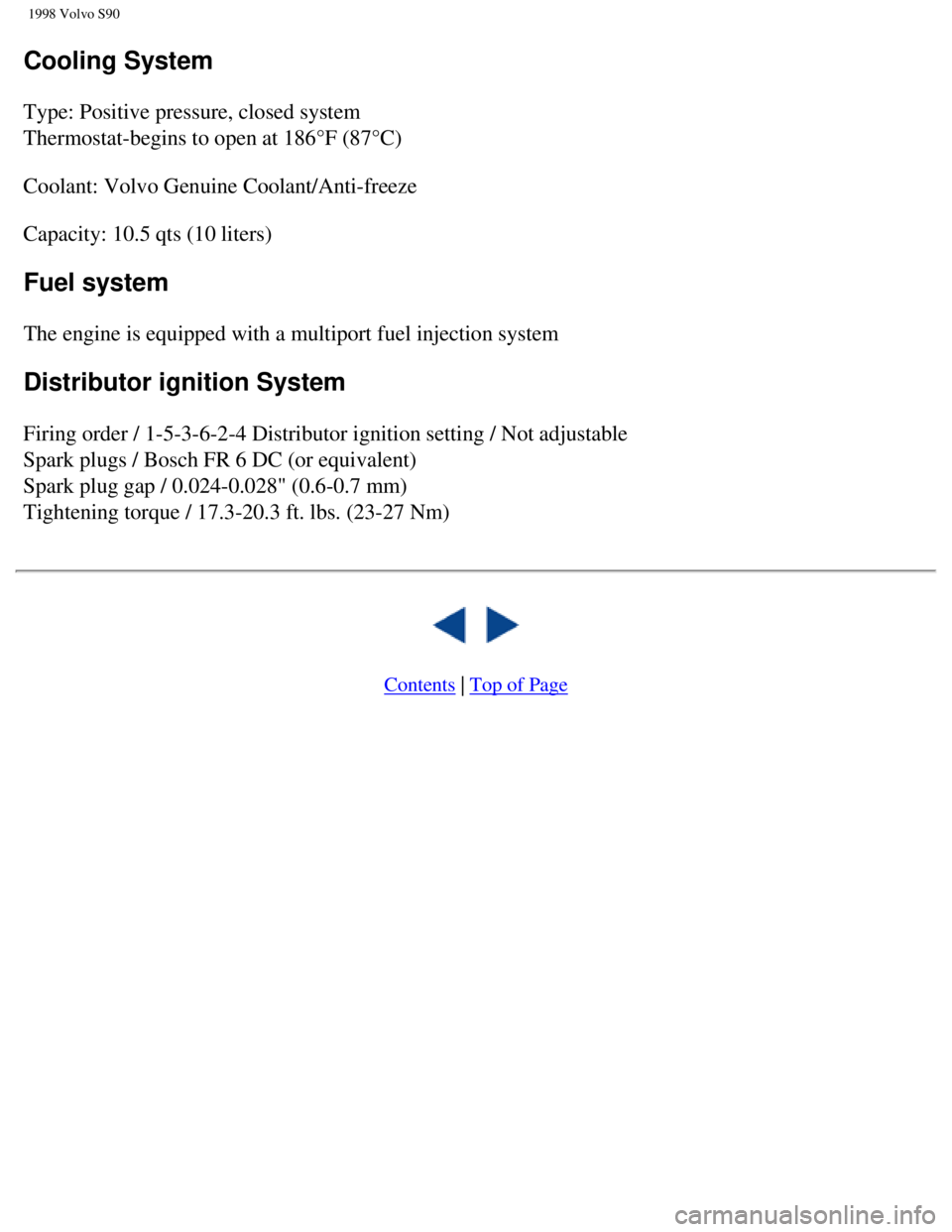
1998 Volvo S90
Cooling System
Type: Positive pressure, closed system
Thermostat-begins to open at 186°F (87°C)
Coolant: Volvo Genuine Coolant/Anti-freeze
Capacity: 10.5 qts (10 liters)
Fuel system
The engine is equipped with a multiport fuel injection system
Distributor ignition System
Firing order / 1-5-3-6-2-4 Distributor ignition setting / Not adjustable\
Spark plugs / Bosch FR 6 DC (or equivalent)
Spark plug gap / 0.024-0.028" (0.6-0.7 mm)
Tightening torque / 17.3-20.3 ft. lbs. (23-27 Nm)
Contents | Top of Page
file:///K|/ownersdocs/1998/1998_SV90/98S90_121.htm (4 of 4)12/30/2006 \
1:52:50 PM
Page 134 of 175
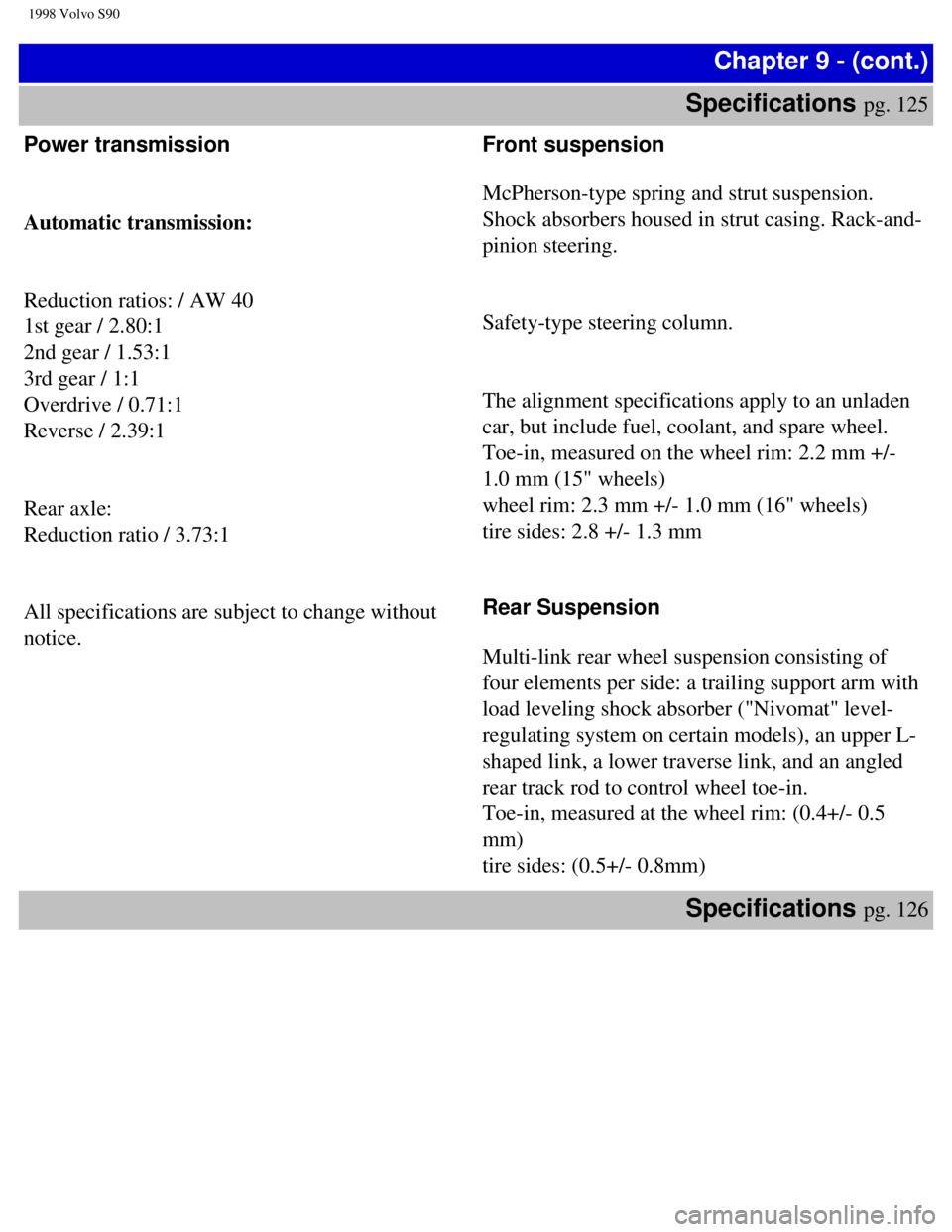
1998 Volvo S90
Chapter 9 - (cont.)
Specifications
pg. 125
Power transmission
Automatic transmission:
Reduction ratios: / AW 40
1st gear / 2.80:1
2nd gear / 1.53:1
3rd gear / 1:1
Overdrive / 0.71:1
Reverse / 2.39:1
Rear axle:
Reduction ratio / 3.73:1
All specifications are subject to change without
notice. Front suspension
McPherson-type spring and strut suspension.
Shock absorbers housed in strut casing. Rack-and-
pinion steering.
Safety-type steering column.
The alignment specifications apply to an unladen
car, but include fuel, coolant, and spare wheel.
Toe-in, measured on the wheel rim: 2.2 mm +/-
1.0 mm (15" wheels)
wheel rim: 2.3 mm +/- 1.0 mm (16" wheels)
tire sides: 2.8 +/- 1.3 mm
Rear Suspension
Multi-link rear wheel suspension consisting of
four elements per side: a trailing support arm with
load leveling shock absorber ("Nivomat" level-
regulating system on certain models), an upper L-
shaped link, a lower traverse link, and an angled
rear track rod to control wheel toe-in.
Toe-in, measured at the wheel rim: (0.4+/- 0.5
mm)
tire sides: (0.5+/- 0.8mm)
Specifications pg. 126
file:///K|/ownersdocs/1998/1998_SV90/98S90_125.htm (1 of 7)12/30/2006 \
1:52:51 PM